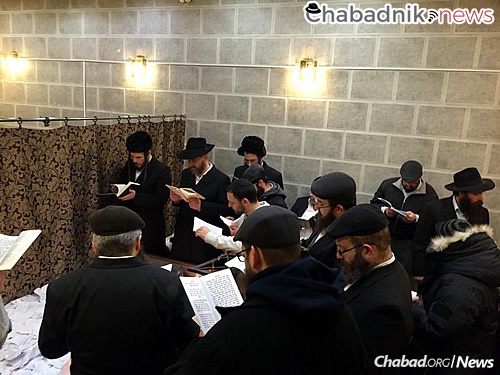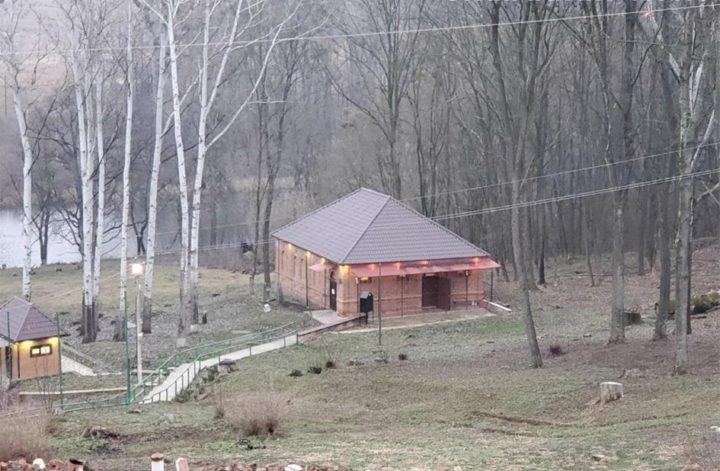In good times and bad, Jews have visited the resting place of Chabad’s founder in Haditch, Ukraine

Today marks 209 years since the passing of the Rabbi Schneur Zalman of Liadi, the founder of the Chabad-Lubavitch movement, in the village of Piena, Russia. Rabbi Schneur Zalman, known widely as the Alter Rebbe, was buried in the Jewish Ukrainian village of Haditch, where a mausoleum was erected and still stands today. This article about Haditch and the people who travel there from all walks of life was first published in 2016.
Eduard Zhak still remembers the day 12 years ago when he first visited the resting place of Rabbi Schneur Zalman of Liadi, the founder of Chabad-Lubavitch, in the small town of Haditch, Ukraine. It was then, like today, the 24th of the Hebrew month of Tevet—the anniversary of the great rabbi’s passing in 1812—and Zhak was there together with a group from his home city of Dnepropetrovsk, about a four-hour drive away.
“We prayed at the resting place, and when we finished and walked outside, Rabbi [Shmuel] Kaminezki [the chief rabbi of Dnepropetrovsk] turned to us and said, ‘Now, for sure, we will be blessed with a good year,’ ” says Zhak. “Something clicked for me then. I remember that well.”
The custom of praying at the gravesite of a righteous person has long been a Jewish tradition, and the ohel (a structure built over a Jewish grave as a sign of prominence of the person buried within) of Rabbi Schneur Zalman—known as the Alter Rebbe—has for two centuries drawn Jews who come to beseech the sage to intercede in heaven on their behalf. In today’s Ukraine, where the din of revolution and war may have subsided but not disappeared, and where economic hardships are now the everyday reality, Haditch has become an increasingly sought-out destination for the country’s embattled Jews. It’s a place of solitary holiness to which they can travel, connect to the Alter Rebbe (and all of the Chabad rebbes) and pray to G‑d.
Zhak, 48, says that he began traveling to Haditch on a regular basis when he was hit by the financial crisis that followed the 2014 Maidan Revolution. “The crisis weighed down on me, and I wanted to look for a mighty defender. The Alter Rebbe is only 300 kilometers away; it’s really not a great distance. A group of us, including Rabbi Mayer Stambler [director of the Federation of Jewish Communities of Ukraine], try to go there once a month.”
“The Alter Rebbe never lived in Ukraine, but he is buried here. It’s like our foremother Rachel, who was buried not at the Cave of the Patriarchs in Hebron, but on the road where the Jewish people could pray at her resting place as they were led into exile. The Alter Rebbe was buried here in Ukraine, close to us Ukrainian Jews. How can we not go there?”

Rabbi Moshe Moskovitz is the chief rabbi and head Chabad emissary of Kharkov, about 200 kilometers east of Haditch. He, too, has seen a growing number of people directing their cars onto the crumbling roads towards Haditch, noting that in addition to the organized trips led by the Jewish communities and schools, recent years have seen people traveling on their own.
“As it’s gotten harder here materially, more and more people have been seeking to connect spiritually,” says Moskovitz.
Jewish businessmen and political leaders are known to visit often. Traveling between his home in Kharkov and his office in Kiev, Oleksandr Feldman—president of the Kharkov Jewish Community and a member of Ukraine’s Parliament—is someone known to go out of his way to pray at the Alter Rebbe’s gravesite, sometimes visiting there as much as three times in a month.
“It is explained that all of the resting places of our rebbes are linked, as are they themselves. Going to Haditch means connecting to and receiving a blessing from our Rebbe as well,” explains Moskovitz, referring to the Lubavitcher Rebbe—Rabbi Menachem M. Schneerson, of righteous memory.
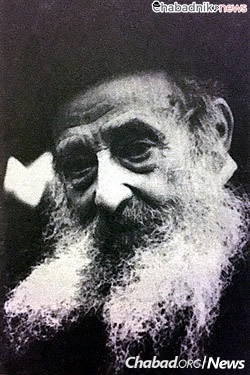
Buried on the Banks of the Psol River
In June of 1812, Napoleon Bonaparte launched his invasion of Russia. From the start, the Alter Rebbe supported the Tsar Alexander I, arguing that while Russia’s anti-Jewish policies oppressed Jews materially, the emancipation promised by Napoleon’s radical liberalism would lead to spiritual destruction. The Alter Rebbe sent letters to Jews throughout Russia, encouraging them to do all they could to aid the Tsar’s war effort. “And as for yourselves, do not be afraid,” the letter concluded. “Do no pay any attention to the enemy’s temporary victories. The final and complete victory will go to the Russian Tsar.”
He also drafted a number of his followers to spy on the eastward movements of the French Grand Armée, including the Chassid Reb Moishe Meisels of Vilna, and his own son, Reb Moshe, who succeeded in infiltrating the headquarters of the French intelligence services, with information being passed on to the Russian authorities.

As Napoleon advanced, the Alter Rebbe was forced leave his home in Liadi, and flee east and then south, wandering together with his family for many months through the harsh winter. On the 19th of Teves, he suddenly became ill and passed away five days later at the age of 68 in the tiny hamlet of Pyena, Russia. He was buried in Haditch which had been his destination at the time.
In the years that followed, thousands of Jews have beaten a path to the Alter Rebbe’s resting place on the banks of the Psol River. Each consecutive Rebbe would travel there to consult with his predecessor, and messengers would be dispatched to pray at the holy site during times of need.
When in 1927 agents of the GPU (precursor of the KGB) burst into the Leningrad home of Rabbi Yosef Yitzchak Schneersohn, the Sixth and Previous Lubavitcher Rebbe, to arrest him, his family looked towards him for immediate instructions.
“What should we do?” inquired the Rebbe’s son-in-law, Rabbi Shmaryahu Gourarie.
“ ‘What should be done?’ I responded,” writes Rabbi Yosef Yitzchak in his memoirs of the arrest, “ ‘First, let emissaries be sent to the graves of my father and my ancestors, the earlier leaders of Chabad, in Rostov, Lubavitch, Nyezin and Haditch, to inform them of my plight … ’ ”
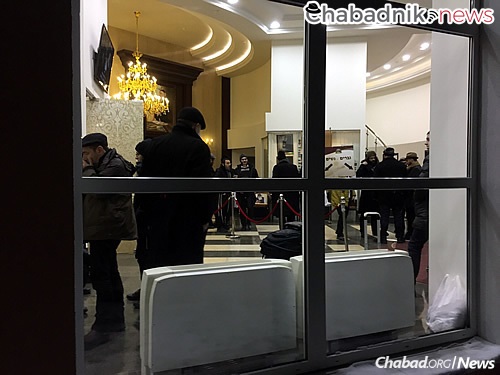
A decade later, in 1939, Stalin’s reign of terror resulted in millions being arrested and sent to the Gulags or liquidated in the purges. The persecution of religious Jews meant that those most dedicated to the preservation of their community’s way of life—the Chabad Chassidim—were targets. A small group of Lubavitchers had been living in the town of Yegoryevsk, 100 kilometers southeast of Moscow, when the sudden appearance of a government informant and the arrests of community members that followed had forced them to pick up and move to Kashira, yet another anonymous town a few hours away from Moscow.
Reb Shmuel Yitzchak Raices was among those who had avoided arrest and safely made the move to Kashira, where the community was able to subsist for the next few years. On a trip to Moscow—at the time, a three-hour train ride to the capital—Raices was met on the street by Reb Yona Kahan, known as Yona Poltaver for the city in Ukraine where he came from.

(Kahan was a legendary Chassidic activist who became the director of the underground Tomchei Temimim yeshivah system in the summer of 1936, after the previous administrators had either been forced into hiding or had been arrested. Kahan would himself be arrested in 1948 and die of malnutrition in a Soviet prison in 1949.)
Kahan informed Raices that at a farbrengen of Chassidim in Moscow, they had appointed Raices to travel to the Alter Rebbe’s ohel in Haditch and deliver their pidyonos—their written requests for blessings from the Rebbe. Raices, who was born with a noticeable limp, made the long trip down to Ukraine without incident, delivering the letters and praying in Haditch before returning home to Kashira.
Not long afterwards, Reb Zalman Levitin (Haditcher), received a call from the GPU, now renamed the NKVD. Levitin, who as his nickname suggests was a native of the town, which at the time was home to a sizeable Jewish community and had even hosted a small branch of the Tomchei Temimim yeshivah for a portion of 1935 and 1936, was a Lubavitcher Chassid who also walked with a limp.
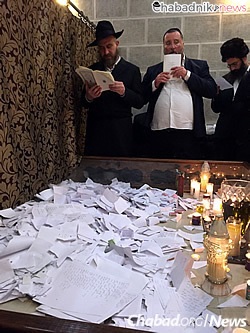
Somebody had informed the secret police that a lone, limping Schneersohnite visitor had visited the grave of the Alter Rebbe. Was it Levitin? The NKVD wanted to know. If it wasn’t him, than who was it?
‘They Start Thinking’
Today, 203 years since the Alter Rebbe’s passing, hundreds of people have made the trek over the snowy roads to pray in Haditch.
Much has changed since the dark days of the Soviet Union. Once an unused and unmaintained Jewish cemetery, when people started coming to Haditch in the early 1990s they had to reach the ohel via a muddy, sloping downhill path. Over the years, many physical improvements to the site have been made: an asphalt path and stairs have been built; the actual ohel has been restored; and a mikvah built as well. Just three years ago, a synagogue and welcome center was dedicated by New York philanthropist George Rohr, in memory of his father Sami and in honor of the Alter Rebbe’s 200th yahrtzeit.
Despite the added comforts of the place, it is still the spiritual connection felt both by local Ukrainian Jews and people who come from around the world that draws them there.
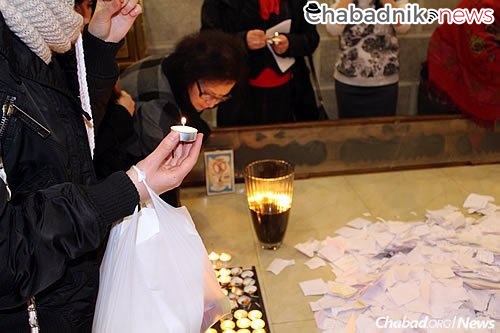
“Haditch is a place that when you come to pray and to ask with an open heart, it is fulfilled,” attests Dan Makagon, who serves as CEO of Shiurei Torah Lubavitch (S.T.L.), a Dnepropetrovsk-based Jewish youth organization that runs popular clubs around the country.
It is when he brings the young people involved with S.T.L. to Haditch, however, that Makagon sees the greatest miracles.
“They go there and start thinking. He or she looks around; they’re not quite sure where they are. Why are they there? They write a letter. To whom are they writing it? That’s when they start thinking about their reality,” says Makagon. “Maybe it’s not just a material world that we live in; maybe it’s not like how I’ve seen it until now. These questions can form a very strong beginning.”
